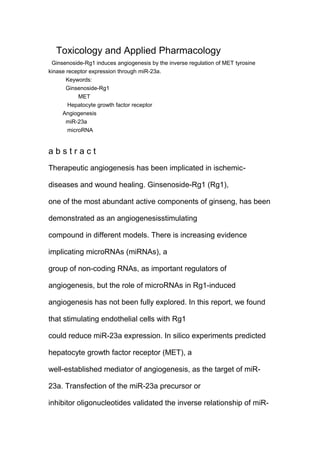
Ginsenoside-Rg1 Induces Angiogenesis by Regulating miR-23a and MET Expression
- 1. Toxicology and Applied Pharmacology Ginsenoside-Rg1 induces angiogenesis by the inverse regulation of MET tyrosine kinase receptor expression through miR-23a. Keywords: Ginsenoside-Rg1 MET Hepatocyte growth factor receptor Angiogenesis miR-23a microRNA a b s t r a c t Therapeutic angiogenesis has been implicated in ischemic- diseases and wound healing. Ginsenoside-Rg1 (Rg1), one of the most abundant active components of ginseng, has been demonstrated as an angiogenesisstimulating compound in different models. There is increasing evidence implicating microRNAs (miRNAs), a group of non-coding RNAs, as important regulators of angiogenesis, but the role of microRNAs in Rg1-induced angiogenesis has not been fully explored. In this report, we found that stimulating endothelial cells with Rg1 could reduce miR-23a expression. In silico experiments predicted hepatocyte growth factor receptor (MET), a well-established mediator of angiogenesis, as the target of miR- 23a. Transfection of the miR-23a precursor or inhibitor oligonucleotides validated the inverse relationship of miR-
- 2. 23a andMET expression. Luciferase reporter assays further confirmed the interaction between miR-23a and theMET mRNA 3′-UTR. Intriguingly, ginsenoside- Rg1 was found to increase MET protein expression in a time- dependent manner.We further demonstrated that ginsenoside-Rg1-induced angiogenic activities were indeed mediated through the down-regulation of miR-23a and subsequent up-regulation ofMET protein expression, as confirmed by gain- and loss-of-function angiogenic experiments. In summary, our results demonstrated that ginsenoside-Rg1 could induce angiogenesis by the inverse regulation of MET tyrosine kinase receptor expression through miR-23a. This study has broadened our understanding of the non-genomic effects of ginsenoside-Rg1, and provided molecular evidence that warrant further development of natural compound as novel angiogenesis- promoting therapy. Introduction Angiogenesis is the formation of new blood vessels from preexisting blood vessels. It is involved in both physiological and pathological conditions such as embryo development (Heinke et al., 2012), wound healing (Li et al., 2005), atherosclerosis (Bochkov et al., 2006), and tumor growth (Carmeliet and Jain, 2000). During angiogenesis, complex cell–cell interactions and various ligand-receptor activations are involved, but endothelial cells play the central role in this process (Augustin et al., 1994). Once activated by angiogenic factors, endothelial
- 3. cells release proteolytic enzymes and migrate to distant sites, where they assemble into new blood vessels. Among the angiogenesis regulatory factors, vascular endothelial growth factor (VEGF) is the best studied and plays a prime role in angiogenesis (Ferrara et al., 2003); however, a number of growth factors, such as epidermal growth factor (Ongusaha et al., 2004), insulin-like growth factor (Tomita et al., 2003; Delafontaine et al., 2004) and hepatocyte growth factor (Tomita et al., 2003), are also involved in supporting angiogenesis. Hepatocyte growth factor/scatter factor (HGF/SF), a plasminogenlike, multi-domain protein, is important for cell proliferation, survival and motility. Upon ligand binding of HGF to the transmembrane tyrosine kinase receptor, hepatocyte growth factor receptor (also known as mesenchymal–epithelial transition factor, MET) dimerizes and recruits different cytoplasmic adaptor proteins (Gherardi et al., 2012). It has been well documented that HGF can stimulate endothelial cell proliferation and induce angiogenesis both in vitro and in vivo (Van Belle et al., 1998), and the downstream signaling pathways play important roles in HGF/MET-mediated angiogenesis. MicroRNAs (miRNAs) are a group of small RNAs of approximately 18– 24 nts. Although miRNAs are non-coding RNAs, they are important in regulating over 30% of gene expression at the post-transcriptional level (Filipowicz et al., 2008; Carthew and Sontheimer, 2009; Macfarlane and Murphy, 2010). Mature miRNAs in the cytoplasm recognize the 3 -′ untranslated region (3 -UTR) of target mRNAs, and their partial complementary′ binding to the 3 -UTR may lead to translational repression of the′ mRNA.Ginseng is the most extensively used Chinese medicine worldwide, and ginsenosides are steroid-like triterpene saponins that are the pharmacologically active components of ginseng. Over 30 ginsenosides have been identified and are classified into three groups: protopanaxadiol, protopanaxatriol and oleic acid derivatives (Shibata et al., 1963). Ginsenoside-Rg1 is one of the most abundant protopanaxatriols, and it has been shown to affect various biological activities, such as blood pressure regulation (Chen et al., 2012), anti-inflammation (Du et al., 2011) and neuro-protection (Chen et al., 2006). Our previous studies have demonstrated that ginsenoside-Rg1 can promote angiogenesis in vitro (Yue et al., 2005) and in vivo (Leung et al., 2006b) through activation of the glucocorticoid receptor (Leung et al., 2006a). Furthermore, miRNA array expression profiling has shown that Rg1 can modulate the expression of a subset of miRNAs to induce angiogenesis (Chan et al., 2009, 2013), but the functional role of those miRNAs has not been fully explored. miR-23a is one of the microRNAs that is regulated by Rg1. In this report, we investigate the functional role of miR-23a in ginsenoside-Rg1-induced angiogenesis.